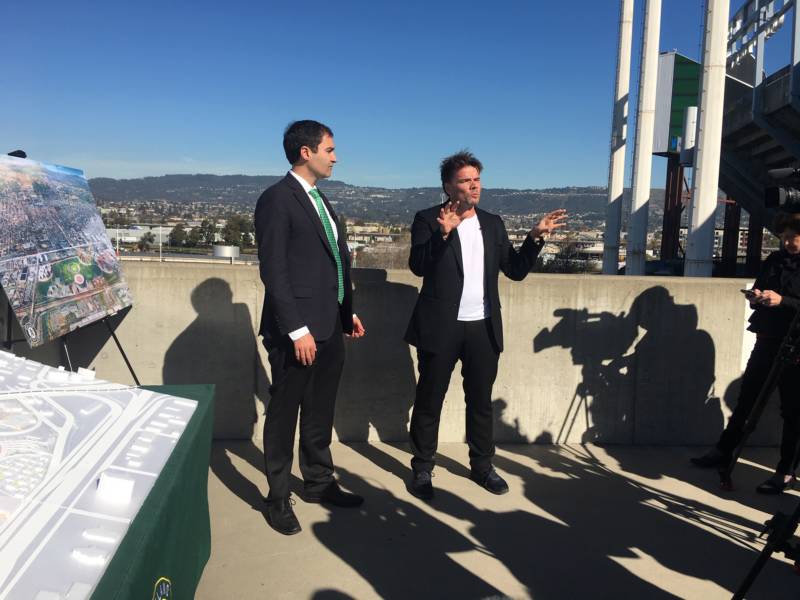The architect responsible for the entire project is Bjarke Ingels, whose company BIG — the Bjarke Ingels Group — is based in New York and his native Denmark. He’s also working on the new Google campus in Sunnyvale. KQED’s Nina Thorsen spoke with Ingels and started by asking him how he would try to prevent the new ballpark he’s designing from feeling out of date in another 40 years.
This interview from Jan. 23, 2019, has been edited for brevity and clarity.
Bjarke Ingels: Well, I think actually there is only one way that you can make a building last forever, and that is to design it in such a way that it will remain relevant and loved by the people using it. I had an epiphany some years ago. I went to Kurdistan, in the north of Iraq, to the sort of cradle of civilization. I went into a village, and I went to a synagogue that was 2,575 years old. It was ruined. There were holes in the roof. It was raining. But I noticed that there was metalwork on the walls. It was rusting away. But it was still there. So I asked, when did they stop using this as a synagogue? And he said in the mid-1950s, because the state of Israel had opened, and all the Jews living in that village moved away.
So that means that the synagogue had been there for two-and-a-half thousand years, perfectly functioning, in a great state of repair, and then just in 50 years it turns into a ruin, because the moment it stopped being relevant to the community, it fell into ruin.
So I think in that sense, what we’re trying to do with the new master plan at the Howard Terminal is to create a ballpark that is not like a big giant elephant in a sea of parking, but actually the green heart, the accessible and open heart of a new community. And here, at the Coliseum site, we’re actually trying to preserve the history and the heritage. So we are actually leaving the lower tiers and the baseball field itself, almost as a Roman ruin, so that five years into the future we would probably be sitting in the middle of a 50-acre green park, with rolling hills that will open up the creeks that are right now piped underneath the parking lot, to become real water elements with green sloping sides.
Then you’ll have this amphitheater, which are the old tiers of the park, looking at a baseball field, where the kids can run around and play in the park and play baseball on the same turf that their historical heroes were playing on a decade before. So in that sense, I think what we’re trying to do with a new site is really to make something that will remain relevant to the people of Oakland because it will be rooted in Oakland. And then also with this site (the Coliseum), to transform it into something that actually preserves and celebrates its past.
Nina Thorsen: One of the things you’re known for is thinking about sustainability not as a punishment, not as something you have to do because it’s good for you. And it sounds to me like a lot of aspects of this concept for both these sites have to do with trying to make sustainability that’s joyous?
Ingels: Yeah, we’ve coined the term “hedonistic sustainability” to remind people that sustainable cities and buildings can actually be more enjoyable than the opposite. And I think the first time where I really learned that was actually our first project ever — 17 years ago we did the Copenhagen Harbour Bath. The port of Copenhagen has become so clean that you can swim in it, so you don’t have to sit in your car for hours to get to the beach. You can jump in the port in the middle of the city. That means that a clean port is not only good for the fish, it’s actually amazing for the citizens of that city.
If you go to the Oakland Coliseum site today, you could think that the “park” in ballpark means “park-ing,” because it’s really a sea of asphalt, as far as you can see from where we’re sitting here. When you go to the ballpark at the Howard Terminal in the future, you’ll actually be able to see the baseball field itself, the turf. But also the entire perimeter of the ballpark is literally going to be a park where on non-game days everybody’s invited to walk and enjoy the greenery, the cafes, the restaurants and the view of the surrounding neighborhood. So in that sense literally bringing the park back in ballpark.
Thorsen: Both here at the Coliseum and at Howard Terminal we’re dealing with waterfront. We’re dealing with the challenges of sea-level rise and climate change, and also more particularly at Howard Terminal there’s a lot of potential groundwater contamination. It’s been an industrial site, it’s near the old Army base. How is your design addressing these issues and trying to work to remediate things?
Ingels: Well, specifically, at the Coliseum site we are creating what we call resilient park landscapes, reusing some of the demolition of the upper tiers of the Oakland A’s stadium, as well as some of the excavation that necessarily goes into a project like this to actually create hills — rolling hills — landscapes to elevate the ground to above the 100-year storm levels, which is roughly 7 meters, more than 20 feet. At the Howard Terminal, we’re going to conduct much more specific investigations of the ground and the water conditions. But our experience is actually that, for instance in Copenhagen, just by making investments in water drainage, instead of just letting all the water wash from the docks into the harbor, but to take it into the sewage system instead.

